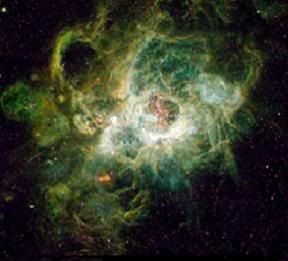|
|
Post by glactus on Dec 9, 2008 4:52:38 GMT
 The Triangulum nebula NGC 604 is an H II region and a hotbed of starbirth in an arm of the Triangulum galaxy M33. It was discovered by William Herschel on September 11, 1784. and is one of the largest H II regions in the Local Group of galaxies. At the galaxy's estimated distance of 2.7 million light-years, its longest diameter is roughly 1500 light-years, over 40 times the size of the visible portion of the Orion Nebula. Variable magnitude is 14.0 At the heart of NGC 604 are over 200 hot stars, much more massive than our Sun (15 to 60 solar masses). They heat the gaseous walls of the nebula making the gas flouresce. Their light also highlights the nebula's three-dimensional shape, like a lantern in a cavern. By studying the physical structure of a giant nebula, astronomers may determine how clusters of massive stars affect the evolution of the interstellar medium of the galaxy. The nebula also yields clues to its star formation history and will improve understanding of the starburst process when a galaxy undergoes a "firestorm" of star formation. It is over 6300 times more luminous than the Orion Nebula, and if it were at the same distance it would outshine Venus. Like all emission nebulae, its gas is ionized by a cluster of massive stars at its center.  Credit: This is a NASA/Hubble image |
|
|
|
Post by Andy Mac on Dec 11, 2008 2:50:04 GMT
M33 can often be difficult to find by amateurs - especially from urban areas. Although a very big galaxy, it has a low surface brightness as its light is spread out over a wide area. Best views are to be obtained from a dark site and by using optical aid with a wide field such as a rich field telescope or even binoculars.
|
|
|
|
Post by carlos on Dec 23, 2008 21:55:55 GMT
Yep.
Best views I've had have been through 70mm binoculars - although I did once see just a hint of spiral structure through a 4" scope.
And once - only the once - I managed to spot it by naked-eye on a very crisp, transparent night, from a VERY dark site.
|
|